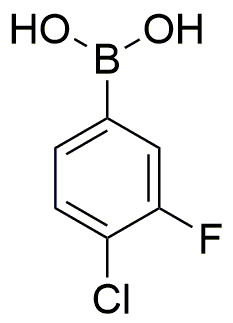4-Chloro-3-fluorophenylboronic acid is widely utilized in research focused on:
- Pharmaceutical Development: This compound plays a crucial role in the synthesis of various pharmaceuticals, particularly in the creation of targeted therapies for cancer treatment.
- Organic Synthesis: It serves as a versatile building block in organic chemistry, enabling the formation of complex molecules through cross-coupling reactions, which are essential in creating new materials.
- Bioconjugation: The compound is used to attach biomolecules in bioconjugation processes, enhancing drug delivery systems and improving the efficacy of therapeutic agents.
- Sensor Technology: It is applied in the development of chemical sensors, particularly for detecting specific ions or molecules, which is valuable in environmental monitoring and safety applications.
- Research in Material Science: This boronic acid derivative is utilized in the development of advanced materials, including polymers and nanomaterials, which have applications in electronics and nanotechnology.
General Information
Properties
Safety and Regulations
Applications
4-Chloro-3-fluorophenylboronic acid is widely utilized in research focused on:
- Pharmaceutical Development: This compound plays a crucial role in the synthesis of various pharmaceuticals, particularly in the creation of targeted therapies for cancer treatment.
- Organic Synthesis: It serves as a versatile building block in organic chemistry, enabling the formation of complex molecules through cross-coupling reactions, which are essential in creating new materials.
- Bioconjugation: The compound is used to attach biomolecules in bioconjugation processes, enhancing drug delivery systems and improving the efficacy of therapeutic agents.
- Sensor Technology: It is applied in the development of chemical sensors, particularly for detecting specific ions or molecules, which is valuable in environmental monitoring and safety applications.
- Research in Material Science: This boronic acid derivative is utilized in the development of advanced materials, including polymers and nanomaterials, which have applications in electronics and nanotechnology.
Documents
Safety Data Sheets (SDS)
The SDS provides comprehensive safety information on handling, storage, and disposal of the product.
Product Specification (PS)
The PS provides a comprehensive breakdown of the product’s properties, including chemical composition, physical state, purity, and storage requirements. It also details acceptable quality ranges and the product's intended applications.
Certificates of Analysis (COA)
Search for Certificates of Analysis (COA) by entering the products Lot Number. Lot and Batch Numbers can be found on a product’s label following the words ‘Lot’ or ‘Batch’.
Numéro de catalogue
Numéro de lot/série
Certificates Of Origin (COO)
This COO confirms the country where the product was manufactured, and also details the materials and components used in it and whether it is derived from natural, synthetic, or other specific sources. This certificate may be required for customs, trade, and regulatory compliance.
Numéro de catalogue
Numéro de lot/série
Safety Data Sheets (SDS)
The SDS provides comprehensive safety information on handling, storage, and disposal of the product.
DownloadProduct Specification (PS)
The PS provides a comprehensive breakdown of the product’s properties, including chemical composition, physical state, purity, and storage requirements. It also details acceptable quality ranges and the product's intended applications.
DownloadCertificates of Analysis (COA)
Search for Certificates of Analysis (COA) by entering the products Lot Number. Lot and Batch Numbers can be found on a product’s label following the words ‘Lot’ or ‘Batch’.
Numéro de catalogue
Numéro de lot/série
Certificates Of Origin (COO)
This COO confirms the country where the product was manufactured, and also details the materials and components used in it and whether it is derived from natural, synthetic, or other specific sources. This certificate may be required for customs, trade, and regulatory compliance.


